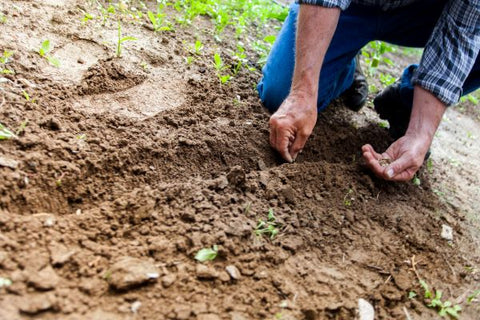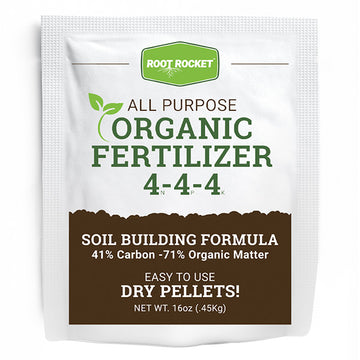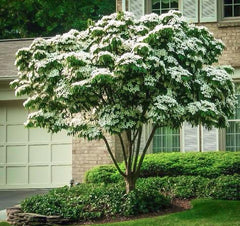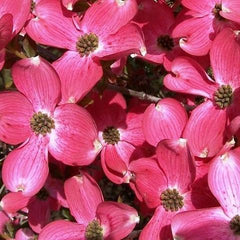Dogwood trees are easily recognizable and incredibly popular in the home landscape and for good reason. These beautiful trees are symbols of spring. They offer dazzling displays in both spring and fall. Enjoy attractive blooms in early or mid spring, depending on the variety, and amazing red autumn foliage. Flowering dogwood trees only reach about 15 to 25 feet tall with a similar spread so they are great for most front yards. They can grow in full sun or part shade. You have some different options when it comes to types of dogwood trees to plant in your yard. Let us help you determine which dogwood type is best for you.
Types of Dogwood Trees
Cornus Florida
This flowering dogwood is an American native tree. It announces spring with its attractive petal-like bracts. It has red berries from fall to winter. We love this tree for its adaptability and tolerance of clay soil, shade, and black walnut and its value for birds and butterflies. Cornus Florida is more heat and shade tolerant than Cornus Kousa. These flowering dogwood trees are recommended for USDA Growing Zones 5, 6, 7, 8, and 9 and come in pink, red, and white varieties.
Buy the Pink Dogwood Tree online. Also, shop the White Dogwood Tree for sale.
Cornus Kousa
The Kousa Dogwood tree is native to East Asia, but has become naturalized in the United States. This flowering dogwood tree blooms after the leaves are fully developed, about a month later than C. Florida. The pointed bracts (petals) differ from C. Florida which has rounded bracts. The Kousa Dogwood grows well in zones 5, 6, 7, and 8. The fruits of this tree are edible. C. Kousa has good disease resistance, especially for anthracnose. Rutgers University gave this tree a higher rating for deer resistance than other flowering dogwood trees. It is also more cold hardy and pest resistant than other flowering dogwood trees.
Shop the hardy White Kousa Dogwood
How to Plant a Dogwood Tree
- Dig a hole about 2 times the width of the rootball/pot.

- Place your dogwood tree in the hole. Check visually from each side to be sure the trunk is straight before you backfill the soil.
- Use the soil you dug out to fill in around the rootball. Tap the soil down with your hands to help eliminate any air pockets.
- Water deeply until the ground is completely saturated.
- Sprinkle our balanced slow release fertilizer on the soil around your plant. Our coated fertilizer is safe for newly planted trees and will help boost your trees establishing roots.
- Add a 2 inch layer of mulch to protect the roots and reduce watering needs.
- Plan on a watering schedule for the first month or two. Water deeply with a hose at the base of your dogwood tree about 2 times per week.
Dogwood Tree Pro Tips
- Dogwood trees have naturally shallow roots which means they can be more susceptible to too much or too little water. The best way to help your tree be healthy and drought tolerant is by watering it properly during the establishment period. Thorough waterings allow deep penetration of water into the soil. This helps the roots grow faster, deeper, and healthier!
- Never plant dogwoods on wet sites. Their roots will suffocate. This can lead to root rot and even death. Consistently wet soil also increases the risk of fungal and bacterial infections as well as insect problems.
- Flowering dogwood trees (C. Florida) are native throughout the Eastern United States from Maine to Florida. This means these trees will adapt easily to these areas and be a beneficial part of the natural ecosystem.
- C. Kousa trees are naturalized in areas of New York. This means that while they are not native to the US, they have successfully grown in these locations and have reproduced and created a natural population. They aren’t invasive and work well with the existing biodiversity of the area.
Now you know about some different types of dogwood trees to plant in your yard and how to plant them. Flowering dogwoods are phenomenal front yard trees. They add curb appeal and increase your property value. They are also easy to grow and maintain once they are established. Hopefully we have helped you find the right flowering dogwood tree for your home landscape. Happy planting!
Browse dogwood trees at PlantingTree online nursery
You May Also Like:
The Dogwood Tree | An American Treasure
Pink Dogwood Tree for Sale | The Basics
Front Yard Trees That Add Curb Appeal
Shop By Color:





